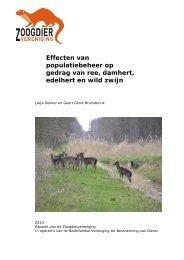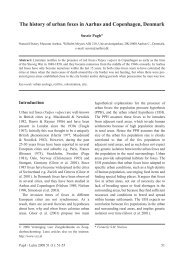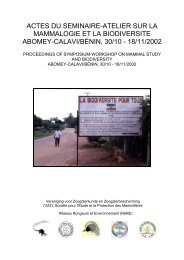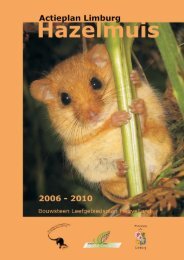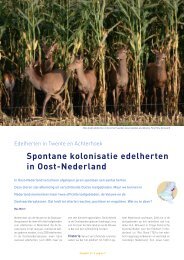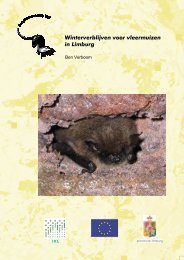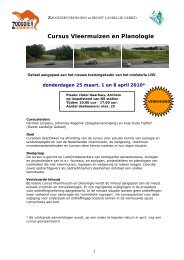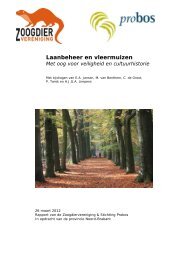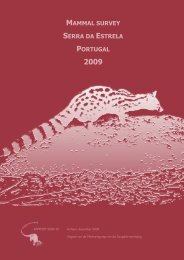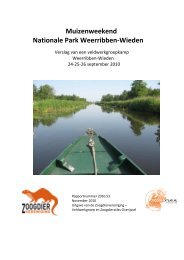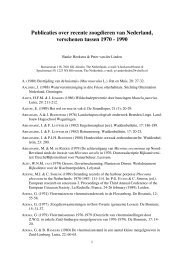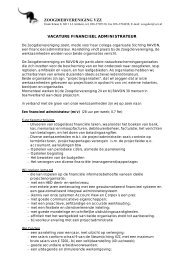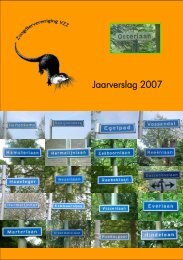Mammal Survey Eastern Rhodopes Bulgaria - De Zoogdiervereniging
Mammal Survey Eastern Rhodopes Bulgaria - De Zoogdiervereniging
Mammal Survey Eastern Rhodopes Bulgaria - De Zoogdiervereniging
- No tags were found...
You also want an ePaper? Increase the reach of your titles
YUMPU automatically turns print PDFs into web optimized ePapers that Google loves.
Kuhl’s bat - Pipistrellus kuhliiNumber of records — 1 - 5 exx. in 10 locations.Type of records — bat detector.Status and distribution — small numbers in and around villages, widespreadSpecial notes — observations of hunting bats (10-20 exx.) indicate the presence of a colonyin the village of Madzharovo.Habitat — hunting in small villages, sheltered habitats along bushes, tree lines,river banks, near street lamps.Roosting preference — in buildings, telegraph poles (see P. pipistrellus).Pipistrelle - Pipistrellus pipistrellusNumber of records — 1 - 10 exx. in >30 locations.Type of records — bat detector, mist netting.Status and distribution — very common and widespread, up to 5 km from villagesSpecial notes — just before and during dawn, roosts could be found by surveying smallvillages. Some individuals were caught departing from a roost, whereflying bats were both identified as P. pipistrellus and P. pygmaeus.Measurements of caught individuals (see below) qualified them as P.pipistrellus (see below).Habitat — near villages, above the river near bridges, all kinds of sheltered habitatsnear vegetation in the vicinity of buildings.Roosting preference — in buildings. Several roosts found. One roost of 34 exx. was found in atelegraph pole in the village of Madzharovo, near a building 2 metersaway. Two other roosts were located in the village of Strandzhevo. One ofthese roosts was found beneath roof tiles of a single house, the secondroost was found in a large building, the bats’ entrance located under theboarding.Pipistrellus pygmaeusNumber of records — several exx. in 8 locations.Type of records — bat detector (8 times) (uncertain).Status and distribution — this species was separated from P. Pipistrellus only quite recently, andtherefore its status is not well known.Special notes — Hunting bats were identified by their peak frequency at 55 kHz, whileflying P. Pipistrellus have a peak frequency at 45 kHz. However, there issome overlap in the range 48-52 kHz, so carefulness is recommended.One roost of a Pipistrellus species was found in two adjacent houses inthe village of Dolni Glavanak, where both species were detected byecholocation. However, measurements of the bats caught at the roost didevidently qualify as P. pipistrellus (see above). Though the bats releasedshowed a peak frequency at 45 kHz, other bats flying at the same locationshowed a peak frequency at 55 kHz. So, it seems likely that bothspecies are present, but no roost was found of P. pygmaeus.Savi’s pipistrelle - Pipistrellus saviiNumber of records — 1 - 2 exx. in 12 locations.Type of records — bat detector.Status and distribution — relatively widespread, small numbers.Special notes — Pipistrellus observed with bat detector were identified as P. savii becauseof peak frequencies at 32-34 kHz and a much slower repetition ratethan other Pipistrellus.Habitat — small river valleys in forested areas, over steep slopes. Was recordedfurther away from villages than other Pipistrellus species.Roosting preference — in buildings and caves. No roosts were found.20 <strong>Mammal</strong> <strong>Survey</strong> <strong>Eastern</strong> Rhodope <strong>Bulgaria</strong>



